Crisp and Chewy Gingersnap Cookies (One Bowl)
This post may contain affiliate links. Please read my disclosure policy.
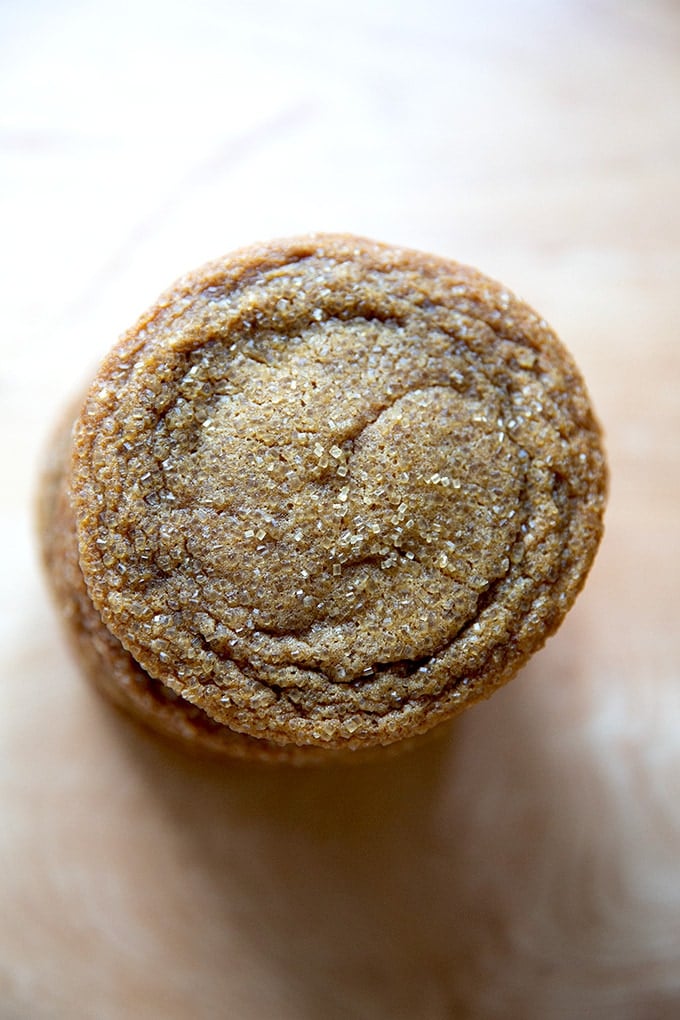
A few months ago at the checkout line of the grocery store, a magazine featuring peppermini-bark stuffed red velvet cookies caught my attention. It was the Bake from Scratch: Holiday Cookies edition, and a quick flip through had me rapt.
This will be the year, I told myself. This will be the year I learn how to make dulce de leche stuffed alfajores and red and green checkerboards and fruit cake whoopie pies and — for my British-treat loving sister — homemade jaffa cakes!!
Upon returning home, I threw that magazine onto the coffee table, where it sat unopened till last Sunday afternoon when one of the children asked when we were going to make Christmas cookies. Hmmmm, I thought, as I eyed the unfolded laundry spilling off the couch, the mudroom littered with mismatched mittens and snow boots that fit nobody, our dinner a far cry from making its way to the table.
BUT: Tis the season!
I picked up the magazine, scrapped my lofty cookie-making dreams, and scanned for an easy-yet-still-festive recipe, one with a short-ish ingredient list, minimal steps, and no frills or frostings.
When I came across a recipe for maple gingersnaps with a photo depicting a tray of ripply-edged, turbinado-sugar coated cookies, my search ended. We made the cookies that evening, making a few teensy changes, most notably using melted butter as opposed to softened, which turned the process into a one-bowl job.
After a 30-minute chill, the dough was ready to be portioned, coated in sugar, and baked. Like Melissa Weller’s chocolate sugar cookie recipe, this one does not require the cookie dough balls to be chilled before baking. Why? Let’s review:
In A Good Bake, Melissa writes: “The rise-and-fall process is a result of the baking soda reacting with the cocoa powder and brown sugar before the cookie is set. When the cookies are removed from the oven, they fall, giving them that crackle top. How quickly the cookie rises before it sets up is the key to achieving that finish.“
To ensure these cookies rise quickly, Melissa doesn’t refrigerate the dough before baking — i.e. room temperature dough rises more quickly than cold dough.
As expected, these gingersnap dough balls puffed in the oven, then collapsed upon cooling. They are crisp at the edges, soft and chewy in the center, and spiced just right with all of those warm, wintry notes we crave this time of year: ginger, cinnamon, and freshly grated nutmeg.
I was drawn to this recipe for the reasons noted above but also for the appealing twist on the classic gingersnap: the replacement of some of the molasses with maple syrup. In the end, I couldn’t really detect the maple flavor, and though I was tempted to make another batch with the molasses completely replaced by the maple syrup I didn’t dare mess with the formula, which not only produced a cookie we unanimously loved, but also scratched the children’s Christmas-cookie making itch. For now, that is.
PS: 30 Christmas Cookies to Make and Gift All Season Long
How to Make Gingersnaps, Step by Step
Gather your ingredients:

For spices, you’ll need: cinnamon, ginger, and nutmeg.

First, melt the butter and let it cool briefly; then add brown sugar, molasses, maple syrup, and salt.
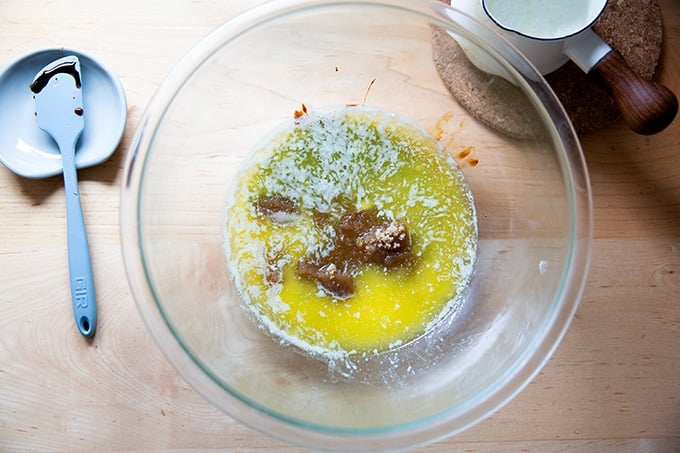
Whisk to combine, then add 1 egg and some vanilla.
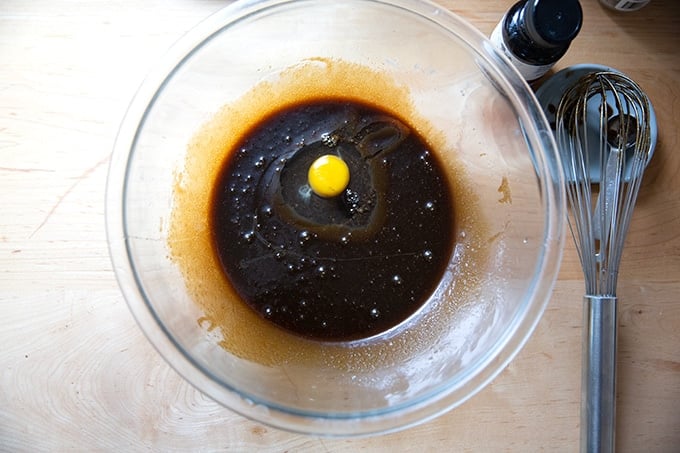
Whisk until smooth then add the spices and baking soda and whisk until blended.

Finally, add the flour and stir just until it is absorbed.

Chill for 30 minutes (or longer if necessary).

Portion the batter roughly into 14 balls.
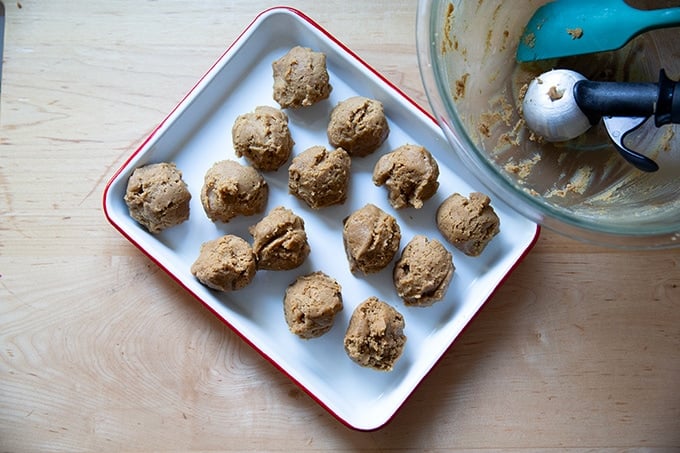
Roll into balls; then coat each one in turbinado or granulated sugar.

Transfer to a sheet pan and bake for 10 to 12 minutes at 350ºF. The cookies will puff as they bake…

… and collapse as they cool. Let them cool completely on the sheet pan.
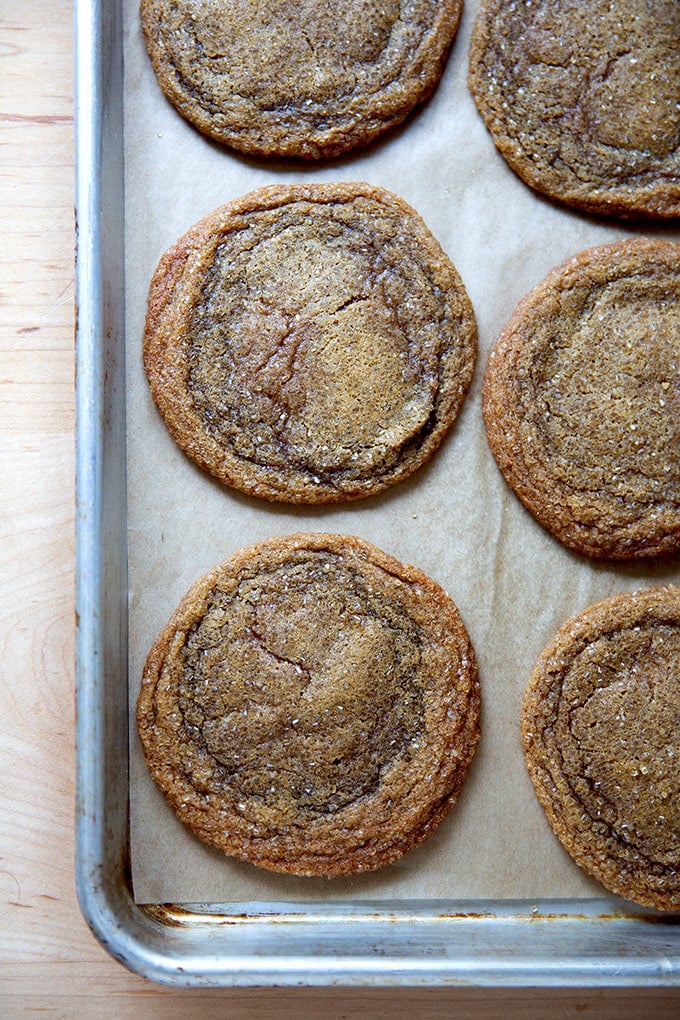
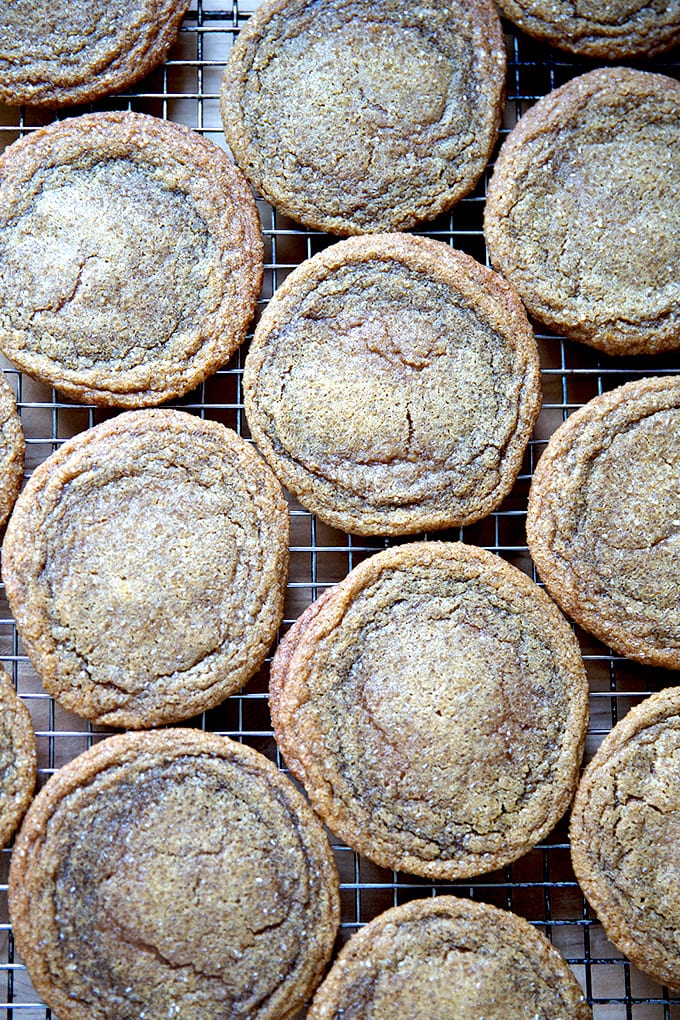
Pile them onto a plate or …
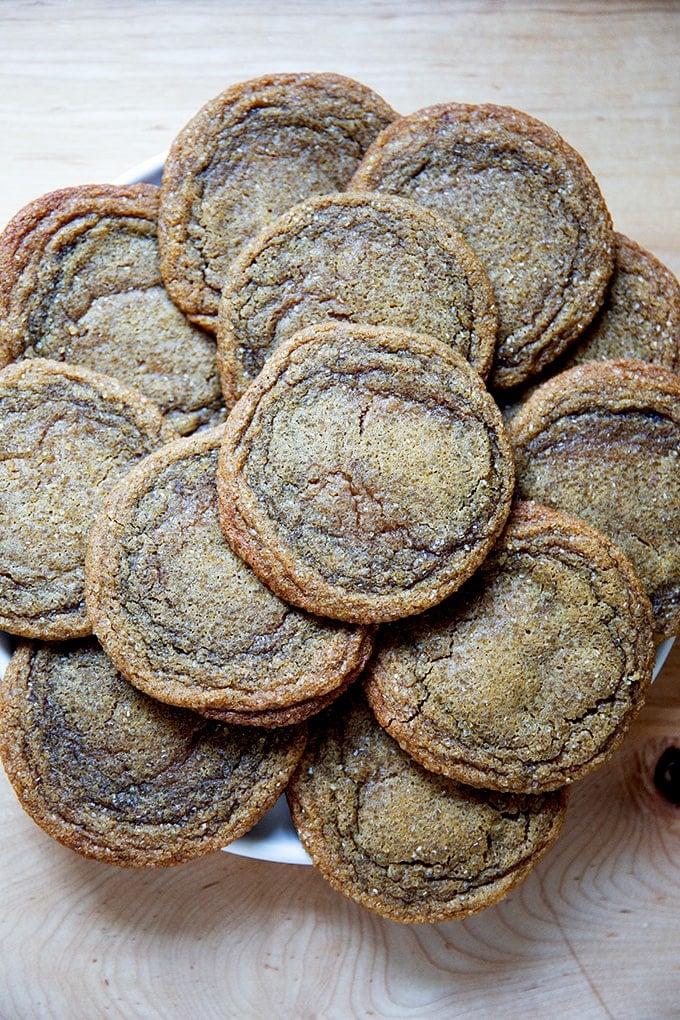
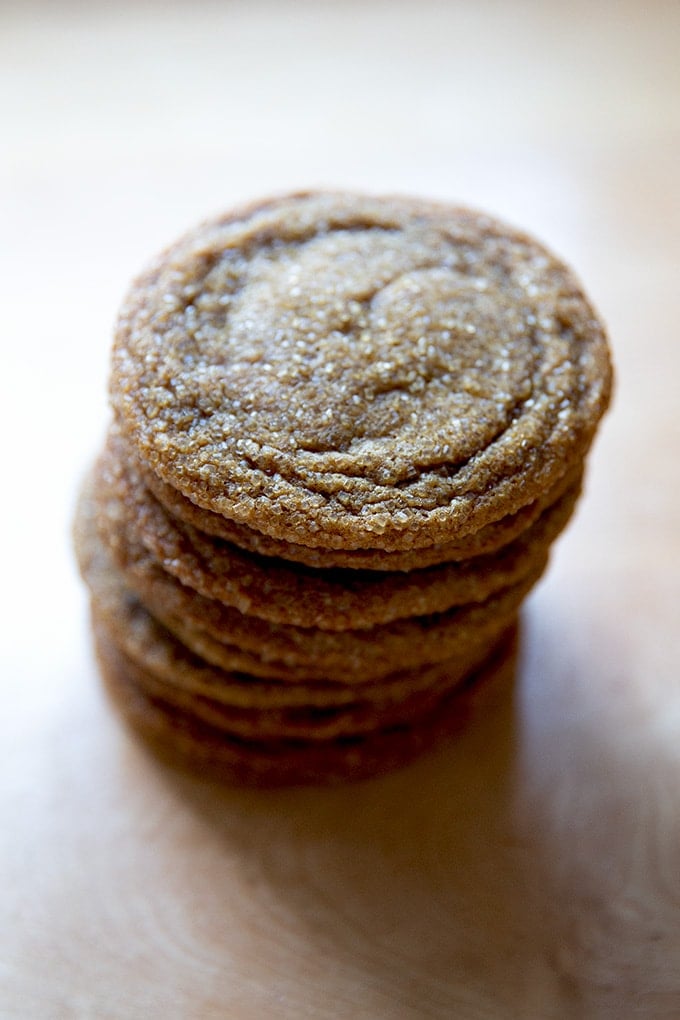
… bag them up and give them away.
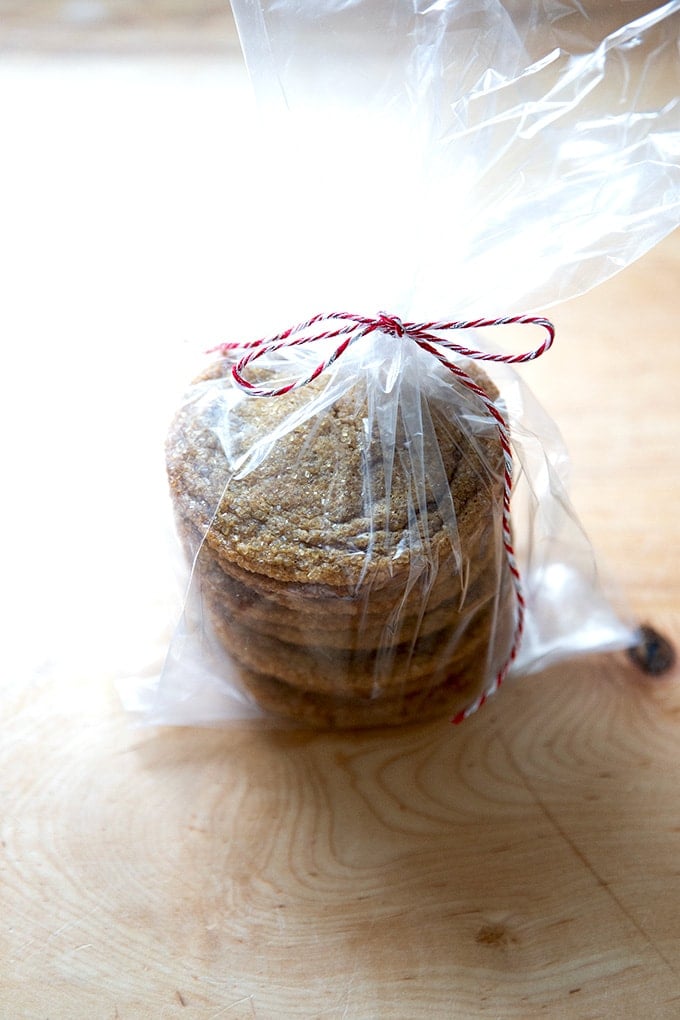
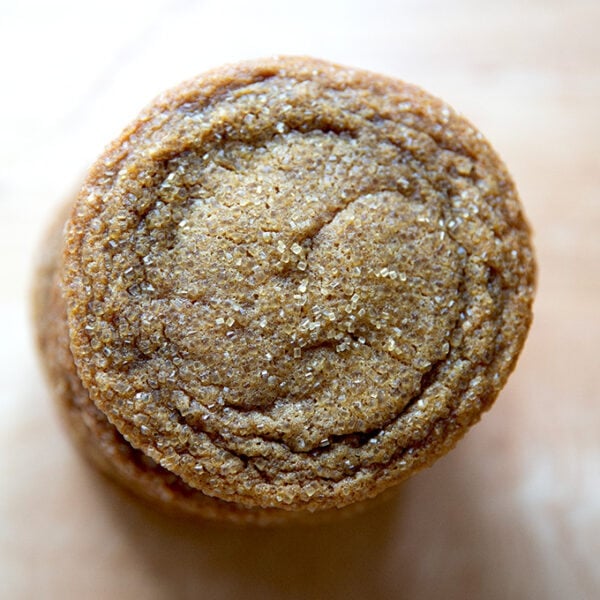
Crisp and Chewy Gingersnap Cookies (One Bowl)
- Total Time: 45 minutes
- Yield: 14
Description
Adapted from the Maple Gingersnap Cookie recipe in the Holiday Cookies Bake From Scratch magazine.
Changes I’ve made to the recipe include using melted butter as opposed to softened, one bowl to mix, a slightly larger cookie size, and a lower baking temperature.
Notes:
- For best results, use a scale to measure. I use the scale both for measuring the ingredients and for portioning the batter into 14 equal balls.
- Molasses: Upon setting out to make these cookies, I found two bottles of molasses in my pantry and I made a batch with each. Conclusion: Do not use blackstrap molasses, which will make your cookies more cake-like in texture and unpleasantly dark in color. Regular molasses or “fancy” is what you need.
- I find chilling the batter necessary after mixing it to allow the batter to firm up and make it easy to portion into balls. After this, I do not find it necessary to chill the portions to prevent spreading. If you are finding that your cookies are spreading, try chilling the portions for at least one hour before baking. You also can chill the balls for longer if that works better for your schedule.
- The material of your sheet pan could also be causing your cookies to spread more. I find my old, slightly blackened pans cause the cookies to brown more on the bottom but spread less. My new sheet pans cause the cookies to brown less and spread a little more.
Ingredients
- 3/4 cup (170 g) unsalted butter
- 3/4 cup (165 g) packed brown sugar
- 3 tablespoons (63 g) maple syrup
- 2 tablespoons (42 g) molasses, see notes above
- 1/2 teaspoon (2 g) kosher salt or fine sea salt
- 1 egg (50 g)
- 1 teaspoon (4 g) vanilla extract or vanilla bean paste
- 2 teaspoons (4 g) ground ginger
- 1 teaspoon (2 g) cinnamon
- 1/4 teaspoon nutmeg, freshly grated if possible
- 2 teaspoons (10 g) baking soda
- 2 cups (260 g) all-purpose flour
- 1/4 to 1/2 cup turbinado or granulated sugar
Instructions
- Melt the butter over low heat and let cool slightly, about 15 minutes.
- In a large bowl whisk together the butter, brown sugar, maple syrup, molasses, and salt.
- Add the egg and vanilla and whisk to combine.
- Add the spices and baking soda and whisk until thoroughly combined.
- Finally, fold in the flour with a spatula. The dough should form a ball, but it will be wet and sticky. If your dough is more like the texture of batter, add more flour a couple tablespoons at a time until it comes together.
- Chill the batter for 30 minutes to allow it to firm up and make it easier to portion into balls.
- Heat the oven to 350ºF.
- Use a scoop or a scale to portion the batter roughly into 14 portions. If using a scale, portion the batter into 50-gram balls. If using a scoop, use a 3-tablespoon spring-loaded scoop or something similar.
- Use your hands to roll each portion into a ball. Place the turbinado sugar or granulated sugar into a bowl. Drop each ball into the bowl and turn to coat.
- Line a sheet pan with parchment paper. Transfer the sugar-coated balls to a sheet pan, being sure to leave enough space in between each ball. On my 1/2 sheet pan, I bake 5 balls at a time. As noted above, I do not find it necessary to chill the portioned balls to prevent spreading, but if you are nervous, bake off one cookie on its own to see how it does. If it spreads more than you would like, chill the remaining portions for at least 1 hour before baking them off.
- Transfer pan to the oven and bake the cookies for 10 to 12 minutes. The cookies will look browned around the edges and will be puffed in the center. Remove the pan from the oven and place it on a cooling rack. If you wish to create ripples at the edges, pick up the pan and drop it two or three times. Let the cookies cool completely on the sheet pan, at least 20 minutes.
- Repeat with the remaining cookie dough balls or transfer the unbaked balls to the fridge until ready to bake.
- Prep Time: 15 minutes
- Cook Time: 30 minutes
- Category: Cookies
- Method: Oven
- Cuisine: American
This post may contain affiliate links. Please read my disclosure policy.




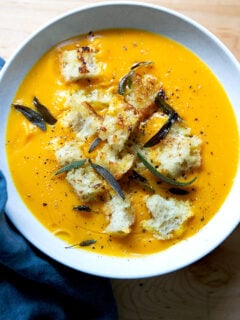
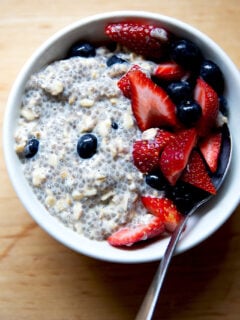
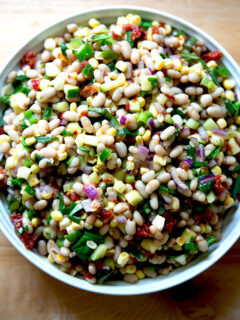




47 Comments on “Crisp and Chewy Gingersnap Cookies (One Bowl)”
Hi Ali. I have gathered and read and I can’t wait to be able to make these cookies. What size scoop are you using?
I don’t have anything but a melon ball scoop or an ice cream scoop.
Your photos are wonderful in your recipe, but there were no pictures of you forming the balls, Or even holding all cooked and ready for a bite! I’m just thinking it might help.
Even trying to do this by hand, you made it look so easy. And they do great!
Hi! I’m likely too late here, but it should be about a 3-tablespoon scoop, so I would maybe use your ice cream scoop but depending on its size, you will likely not have to fill it entirely. You will have 14 balls in the end. I don’t have a scoop that is perfect for shaping these balls, but if I find one, I’ll link to it.
You always come through with the perfect recipes in the nick of time (especially at the holidays!) – I have made your overnight brioche cinnamon rolls on Christmas eve for years, used and loved your ham sauce, and am basically obsessed with the rosemary shortbread. I can’t wait to try this one!
Thank you, Abby 🙂 🙂 🙂 So nice to read all of this. Hope you love these, too. Happy holidays!
yum, new kind off cookie for me, I’m so happy your kids inspired you to make them! Nice walk through photos too, thank you
Thanks Sabrina 💕💕💕
Ali, this is so timely. Right before I read this email, I asked my husband, “Why is it that every
Christmas I plan to have a day full of cookie baking and yet every year I don’t do it?”
Then I proclaimed, “This is the year and today is the day!”
I then went to your site and saw this post. I cracked up!
So today, I am trying your Chewy Chocolate Sugar Cookies, shortbread, one of your gingerbread cookies and your new poundcake in mini loaves. I am looking forward to the results as two of your other holiday cookie recipes are already family traditions.
As always, thanks for sharing! I will report back with results.
Yay!!! I hope your day of baking was a success… I was driving home from Western New York in a snowstorm and treated myself to shortbread and gingersnaps upon walking through the door 🙂 🙂 🙂 Happy happy holidays to you and your family. xoxo
Hi Ali,
What are your thoughts are Grandma’s (original) Molasses, organic Wholesome Molasses or Pure Sorghum Molasses? None of them are labeled as blackstrap. If I don’t hear back by the time I bake, I’ll report back! I love your recipes.
Thank you!
I think any of those should be just fine! Good luck! And thank you 🙂
Happened to have all the ingredients in my house so I had to make these. They turned out so dang tasty, not overly sweet either. Thank you!
Great to hear, Brie! Thanks so much for writing 🙂 🙂 🙂
These were delicious! Thank you ❤️
Great to hear, Annie 🙂 🙂 🙂
Hi Ali!
All of these cookies look so so good. I am a big cookie person. But I got to thinking that this recipe may turn out very well if put in a pizzelle maker. We love ours thin and crispy and it might be what I am looking for.
Thanks so much for all you do- love this blog and your videos. And I am still working on that perfect Dome pizza. So far the best ones have been partially baked without toppings. Then topped and baked again. Like biscotti twice baked!
Xo
I love the pizzelle idea! I think this dough, pressed thinly and baked longer, will be beautifully crisp. I do find, however, that these cookies don’t stay that crisp upon being stored, and I’d hate for you to be disappointed on days 2 and beyond.
Glad to hear you are making progress with the Dome. I do think a parbake is helpful for so many people looking for that crisper crust.
Haha. You expect them to last more than 2 days? Thats really funny. Mixing them up today. Will let you know the results.
Your holiday day menu sounds wonderful. I cant make it all for just two people but there are a few calling out to me.
🤣🤣🤣🤣
Got it. Happy Baking!
So easy & so delicious! Less sticky & messy to roll dough portions into balls than my (formerly) favorite easy ginger cookie recipe. And these stayed soft, which is not consistently the case with my old recipe.
Only change was to reduce the size of cookies, 20 grams is a good size for our family AND they fit in the cookie tins I give my sisters for Christmas every year 🤗
Oh yay! So nice to hear this, Anne! Thanks so much for writing. A smaller size is so nice this time of year, when multiple cookies are making their way into the cookie tins. Happy holidays!
Thank you! Just as you described! Delicious! An extra chill before they went into the oven because a bit too soft.
Great to hear, Laura! Thanks for writing 🙂 🙂 🙂
I wanted to love this recipe – haven’t found one on this site that I won’t make again until this one. Made it to the letter – weighed everything as directed and my sole modification was to add a quarter teaspoon of ground cloves. Chilled the dough before portioning, weighed each portion, and chilled again. Put five balls in a half sheet – and they ran together and flattened to about a quarter inch when removed from the oven. They were huge! I re-portioned the remaining dough down to 30 grams to see if that would help avoid the pancake outcome. And those also ran together and flattened until they resembled tuiles. My husband and I will eat and enjoy them, but they don’t make my holiday cookie cut.
Any ideas what I might have done wrong? I’ve never had a problem or disappointment with any other cake, cookie, bread or pie recipe – and your mom’s peasant bread is my standby.
So strange Nancy! Questions: when you mixed the batter, did it form a ball? Or was it more liquidy/runny? My only thought is that for whatever reason you may need to use a little more flour. What type of flour are you using?
I made these to gift, but asked my husband if he liked ginger snaps, he said not really … he’s eaten 4 right away … apparently he likes these :0)
Ha! Love this so much 🙂 🙂 🙂 Thanks so much for writing, Helen! Happy holidays 💕💕💕
Hi Alexandra! Love the flavor of these cookies. But mine didn’t get flat and chewy. I’m going to try a different molasses next time but any other ideas why that might happen? Granted, I’ve never managed to get a cookie flat and chewy!
Hi Rachel! Did they stay puffed? Did you use blackstrap molasses? And are you using a scale to measure? Finally, what type of butter are you using?
Hi Alexandra!
They did stay puffed. And I believe it was blackstrap molasses but I cut the quantity in half. I did not use a scale this time. I used unsalted butter as well. Thank you! You’re the best.
Hi Rachel! It might be because of the blackstrap molasses, which gives the cookies a cakier texture. A few people have had issues with the texture though, so I’m wondering also if the type of butter is making a difference due to the variances of butterfat percentages in different butters.
Thank you for your help! I will try again and let you know how it goes!
I made the big chewy crispy ginger cookies . I am a cookie baker . These cookies are simply put DIVINE . 🤩Everyone went crazy for them . From their lovely big size to the chewy middle and crispy edge . Oh my gosh . Unbelievably superb .
Thank you Ali
Oh Yay! So nice to hear this Deborah 🙂 🙂 🙂 Thanks so much for writing. Happy holidays!!
These are delicious! Mine came out very large and yummy! Do you think I could make the ball half the size (25 grams) and cook for 8-10 minutes and get the same delicious cookie? What would you recommend? Weighing all the ingredients is a game-changer! It makes such a difference in the result! 🙂
Great to hear, Lisa! Yes, absolutely, make 25-gram balls, and bake for 8 to 10 minutes. Thanks for writing!
Hi Ali, I was excited to make these cookies; I love your website & recipes! I weighed all of my ingredients, including butter & egg, but didn’t weigh spices and baking soda, but did fluff the baking soda before measuring. I did not use blackstrap molasses. My dough came out looking like yours and I let it chill for a few hours before rolling into balls. I weighed out dough balls, to 30 g. My cookies baked up flat and joined together, darn. I was even careful to melt my butter till just melted, not over-melted. I use Kirkland unsalted butter from Costco. I let the rest of the dough chill overnight and decided I’d weigh the dough balls to 20 g. They still spread, but not all of them joined. The cookies are very flat and kind of greasy. I use an AP organic flour from Costco.
I can’t figure out where I went wrong–any ideas? The flavor is very good, but like I said, they’re kind of greasy & flat.
Merry Christmas to you & your family and thanks for all of the wonderful content you give.
Hi Laura! I am wondering if the type of butter is the culprit. A few people have had issues with the texture, and I can’t figure it out, especially when all ingredients are weighed and blackstrap molasses were not used. I use Cabot butter, and I wonder if the difference in butterfat is making the difference. I do find certain sheet pans cause more spreading than others, but I don’t think the sheet pans would explain the greasiness. I’m sorry for the trouble with this one!
Hi Ali,
I’m hoping to use a Gluten/Nut-Free flour for a friend that’s celiac and anaphalactic. is there a specific flour that would work well with this recipe?
Thank you so much – we are such HUGE fans of your recipes.
Hi Denise! Thank you for your kind words 🙂 I have luck with KAF gluten-free flour and Thomas Keller’s Cup4Cup. I believe both of those are nut-free products as well. Hope that helps!
Hello, can you suggest any replacement for maple syrup? Thank you!
I would simply use 3 more tablespoons of brown sugar.
This will be my second Christmas baking these cookies. They are perfect and were a huge hit at a lunch for our cousins visiting from Wales last year. They took the recipe home with them! They turned out so well we gave them as gifts to a few friends and they also called and asked for the recipe- a true sign of a delicious cookie. I made 50gm size and 25gm size and both baked perfect. Thank you for this wonderful recipe.
Great to hear, Lisa! Thanks so much for writing. I’m so looking forward to Xmas cookie season!
I tried these and the chewy chocolate sugar cookies and while they taste and smell delicious, they surprisingly didn’t really spread out like I expected them too. I rolled them into a ball and they were each 50 grams so I’m not sure what would cause them not to spread much? I was expecting more of a flat cookie and mine look like regular ones which is totally fine just not what I was expecting. Any ideas for what might have gone amiss?
Hi! It sounds as though you did use a scale to measure the ingredients, right? What kind of butter are you using? And what kind of flour are you using?
Yep, I used a kitchen scale, unsalted butter from Vital Farms and Uncle Bob’s organic all purpose flour (but needed a little bit more so I added some TJs organic all purpose unbleached flour to it, like 50 grams or so). I did adjust the sugar by a touch, but not a lot, maybe taking out about 50ish grams there? I mean they taste fantastic, they just didn’t spread haha so it’s not the end of the world, I was just surprised! My other ones didn’t spread either so it feels like something I must be doing wrong!
It sounds as though you are doing everything right! I think if you want your cookies to spread given your environment and the flour and other ingredients you are using, it will simply be a matter of using less flour. I do think that subtle differences (the butter fat content of the butter, for instance, or the type of flour) can add up and cause variances in the results. Try holding back 25-50 grams of flour next time and see how they turn out 🙂